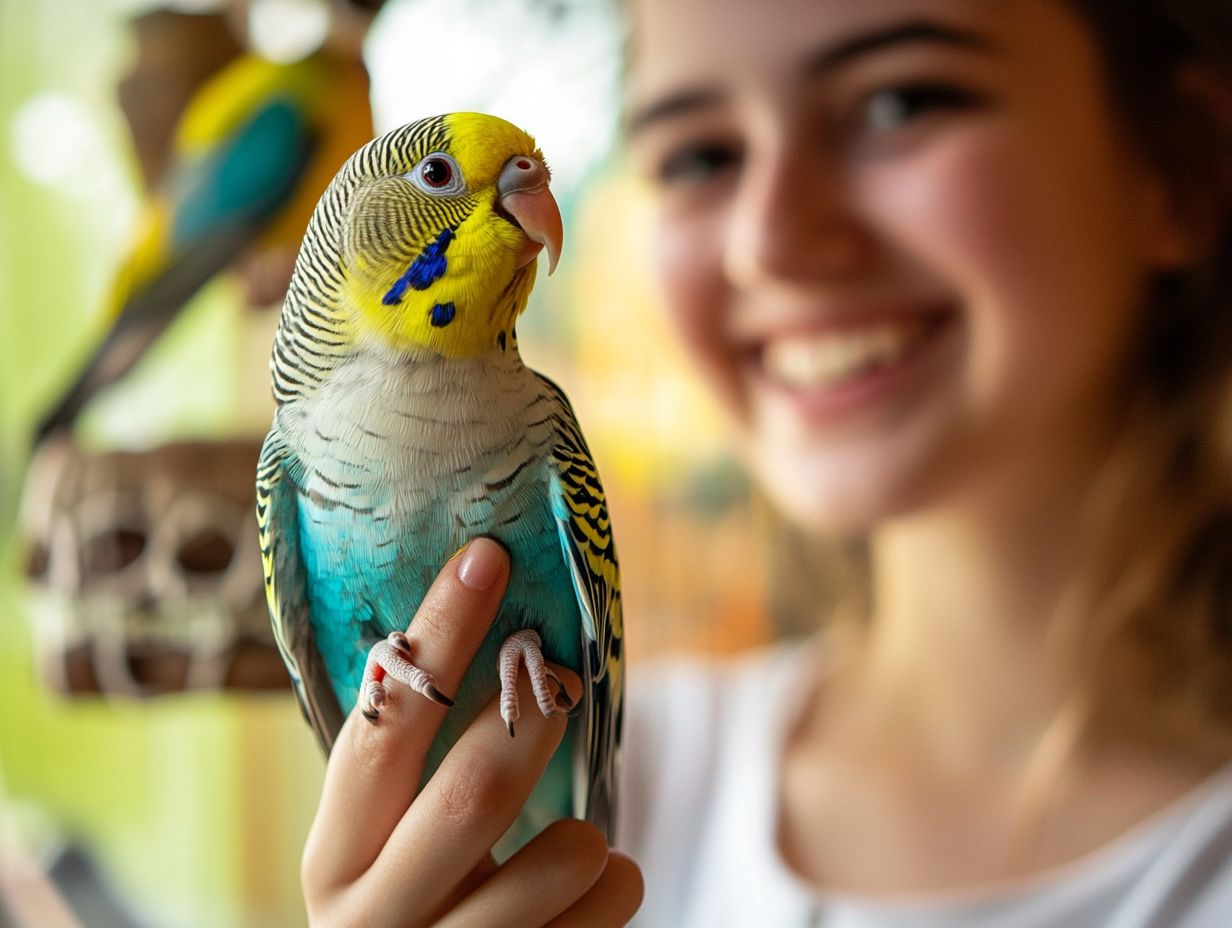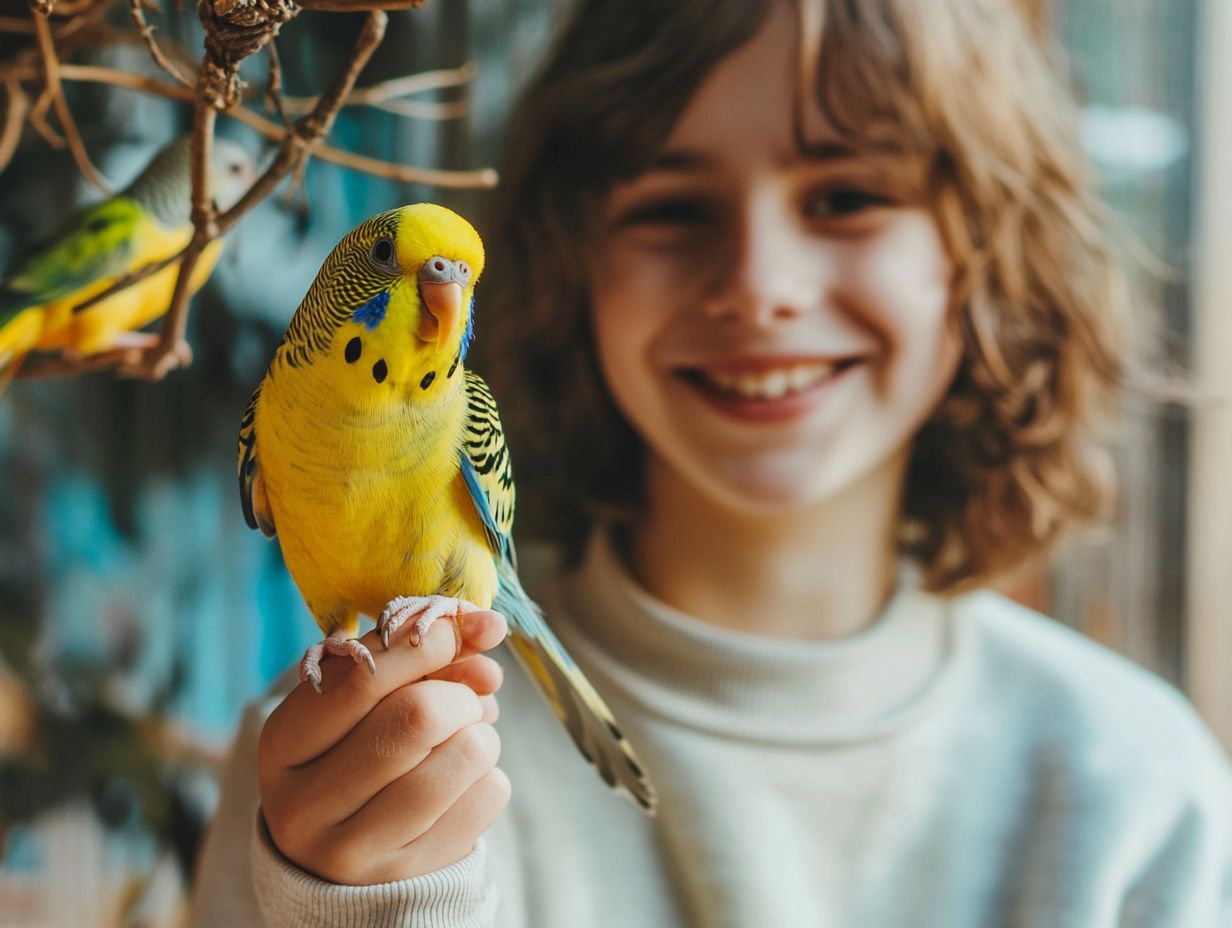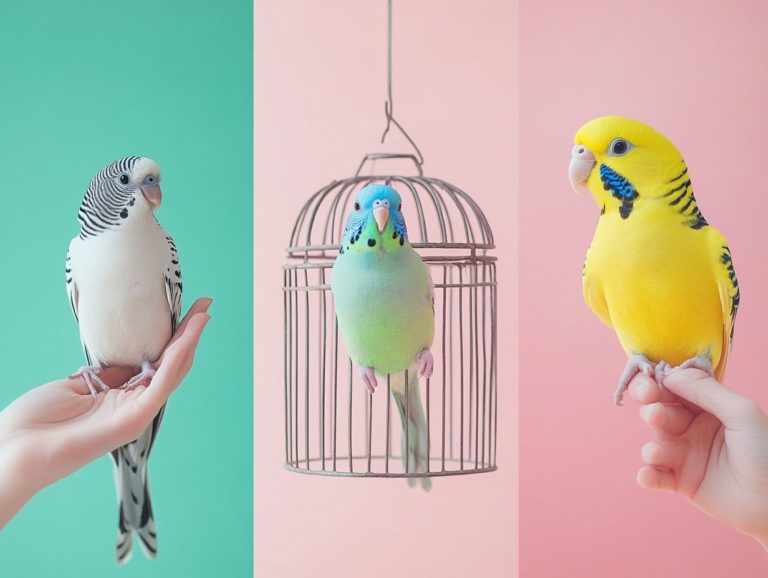How to Bond With Your Newly Adopted Bird
Bringing a new bird into your home marks the beginning of an exhilarating journey brimming with joy, discovery, and the promise of a unique bond.
To ensure a seamless transition for you and your feathered companion, create a nurturing environment and gather the essential supplies.
From those initial introductions to establishing routines, and from deciphering their body language to nurturing your relationship through engaging play, this guide gives you the essential tools you need to succeed!
We will tackle common challenges, equipping you to deftly navigate any bumps along the way.
Get ready to embark on an exciting adventure with your new feathered friend!
Contents
- Key Takeaways:
- Preparing for Your New Bird
- Introducing Your Bird to Its New Home
- Building Trust with Your Bird
- Nurturing Your Bond with Your Bird
- Dealing with Challenges
- Frequently Asked Questions
- How can I bond with my newly adopted bird?
- What are some tips for creating a bond with my new bird?
- Should I give my newly adopted bird some alone time?
- What activities can I do with my newly adopted bird to bond with them?
- Is it important to establish a routine for bonding with my new bird?
- How long will it take for my newly adopted bird to bond with me?
Key Takeaways:

- Create a welcoming environment for your new bird by providing proper supplies and setting up a routine.
- Build a strong bond with your bird by understanding its behavior and using positive reinforcement training.
- Nurture your relationship through activities and handling, and address challenges with patience and understanding.
Preparing for Your New Bird
Bringing a new bird into your home is an exhilarating adventure that requires thoughtful preparation. This ensures a seamless transition for your feathered companion. From choosing the perfect species whether it s a cockatoo, African gray, Amazon parrot, or conure to creating a welcoming environment with a cozy cage setup and familiar food, every detail counts.
Recognizing that your bird loves interacting with people is crucial. They flourish on times spent together building a friendship. Employing effective training techniques, including a gradual introduction to their new surroundings, will help foster a strong trust bond. For more guidance, check out this resource on how to create a safe space for your adopted bird. This foundation paves the way for a joyful and harmonious relationship.
Creating a Suitable Environment
Creating a suitable environment for your new bird is essential for its comfort and well-being. Begin with a thoughtfully designed cage that mimics its natural habitat.
Consider dimensions that provide ample space for movement; a cage should ideally be at least twice the bird’s wingspan in both width and height. Placing it in a low-traffic area significantly reduces stress and offers a sense of security.
Incorporating safety features, like non-toxic materials and secure locking mechanisms, is crucial to prevent any escapes or accidents. Including familiar toys and accessories such as perches and swings will ease the bird’s transition, enhancing the acclimatization process. This thoughtful approach will help your feathered friend feel right at home, ultimately promoting a happier, healthier life.
Supplies and Equipment You’ll Need
To ensure a seamless transition for your new bird, gather these essential supplies and equipment tailored to its needs for food, play, and training.
Begin by selecting high-quality pellets and a variety of seeds, as these will make up the core of its diet. Don’t forget to include fresh fruits and vegetables to provide those essential vitamins. For toys, choose those that promote natural behaviors like foraging and chewing to keep your feathered friend engaged. A suitable cage, furnished with perches, swings, and safe, bird-proof toys, will help create a cozy environment.
Also, remember the significance of regular physical activity and mental stimulation. Engaging your avian companion in daily exercises and offering interactive playtime will greatly enhance its overall well-being.
Introducing Your Bird to Its New Home
Introducing your bird to its new home is a vital process that demands both patience and a thoughtful approach to cultivate a trusting bond. To strengthen this connection, you may want to explore the best ways to bond with your bird. Give your feathered friend the time it needs to acclimate without feeling overwhelmed.
Start with a gradual introduction, allowing your bird to explore its new environment at its own pace while you keenly observe its behavior. Focus your initial interactions on fostering trust, ensuring that your new companion, whether it’s a vibrant conure or a more reserved African gray, feels safe and secure in its surroundings. For more guidance, check out this article on how to socialize your new bird.
Initial Interactions and Bonding Techniques

Establishing initial interactions with your new bird is crucial for creating a lasting bond. Learning how to give your adopted bird a happy home can significantly influence your bird’s adjustment period.
Adopting a gentle and patient approach is key. Soft handling will help your bird feel safe and secure. Engaging in calming activities like speaking softly or even singing can create a soothing atmosphere, signaling to your bird that it s in a caring space.
Make sure their cage is comfortable, equipped with perches at varying heights and safe toys to encourage exploration and interaction. Daily routines, such as offering treats from your hand or allowing your bird to perch on your shoulder, are excellent ways to build trust.
Implementing these simple yet impactful practices will set the foundation for a deep and rewarding companionship.
Establishing a Routine
Establishing a routine for your new bird is vital for its adaptation and well-being, offering the structure and predictability it craves in daily life.
Incorporating consistent feeding times not only meets its nutritional needs but also cultivates a sense of security. This allows your feathered companion to anticipate meal times with eager expectation. Regular training sessions can further enhance its thinking skills while strengthening the bond.
Playtime is equally important. Engaging in activities that encourage exploration and exercise keeps your bird mentally stimulated and physically fit. Daily interaction whether through conversation or gentle handling deepens the emotional connection, helping your bird feel more at home in its new surroundings.
Building Trust with Your Bird
Start building trust with your bird; it’s an exciting journey that requires patience and understanding. To make this journey even more special, consider exploring how to celebrate your bird’s adoption anniversary. It involves employing effective techniques to establish a strong, lasting bond, essential for nurturing a healthy relationship.
Understanding Body Language and Behavior
Understanding your bird’s body language and behavior is essential for cultivating a trusting relationship. It allows you to accurately interpret its feelings and needs.
By paying close attention to these subtle cues, you can elevate your interactions. This ensures that your feathered companion feels both secure and understood. For example, an upright posture typically indicates confidence and comfort, whereas drooping wings or fluffed feathers may signal stress or a chill in the air.
If your bird frequently preens itself, it s often a sign of contentment and relaxation. On the other hand, avoiding eye contact might suggest unease or a desire for personal space. Recognizing these signals enables you to tailor your approach, ultimately fostering a deeper bond and enhancing communication over time.
Positive Reinforcement Training
Positive reinforcement training is an exceptionally effective way to teach your bird new behaviors while simultaneously strengthening the bond between you both. By using rewards tailored to your bird’s preferences, you create a learning environment that is both enjoyable and productive.
This approach not only enhances the overall learning experience but also cultivates trust and communication between you and your feathered friend. You can use small treats like slices of fruit or bird-safe seeds as rewards when your bird successfully performs a desired action, such as stepping onto your hand or mimicking a sound.
Verbal praise and gentle petting can be powerful motivators, reinforcing positive behavior without relying solely on food. Engaging in training exercises like target training where your bird learns to follow a stick for rewards can be a delightful way to build skills while recognizing and celebrating each achievement with enthusiasm.
Ready to see your bird learn new tricks?
Nurturing Your Bond with Your Bird

Nurturing your bond with your bird transcends mere care and training. It invites you to engage in enriching activities and games that resonate with your bird’s playful spirit as a social being, and understanding their needs is crucial. For more insights, check out understanding the behavior of adopted birds.
Try these bonding techniques today and watch your relationship flourish!
Activities and Games to Strengthen Your Relationship
Engaging in activities and games with your bird is a delightful way to deepen your bond. It provides both mental stimulation and valuable opportunities for interaction. These playful moments enhance their environment and deliver essential exercise and mental challenges that align with their natural instincts.
Imagine offering a variety of familiar toys like swings, mirrors, and chewable items. You can also participate in interactive games such as hiding treats or teaching tricks. The fun options are endless! Different bird species thrive on various types of engagement, so it s vital to observe their preferences closely.
By rotating toys and introducing new activities, you can keep your feathered companion mentally sharp and joyfully engaged. This ensures that playtime remains a fulfilling and enjoyable experience for both of you.
Handling and Socializing Your New Bird
Handling and socializing your bird are vital for cultivating a strong trust bond through positive reinforcement. Fostering interaction with your bird in a familiar environment plays a key role in their comfort with human interaction.
By taking gradual steps to introduce gentle touches and interaction techniques, you can create a safe environment that encourages your feathered friend to feel at ease. Using treats, such as their favorite seeds or fruits, can help familiarize your bird and establish a positive association with these interactions.
This enjoyable approach builds your bird’s confidence and personality, helping everyone appreciate its unique traits. Make sure that each interaction remains pleasant to strengthen that trusting bond.
Dealing with Challenges
Navigating the challenges of bird ownership, especially with social species like cockatoos and conures, is an integral part of the experience. By familiarizing yourself with common issues, such as sound sensitivity and behavioral problems, you equip yourself to provide effective solutions and bonding tips. This will elevate your training skills for your bird to new heights.
Common Issues and How to Address Them
Common issues like sound sensitivity and behavioral problems may arise as you acclimate your new bird, but with a little insight, you can address them effectively.
By recognizing the signs of anxiety during the gradual introduction process or distress that can occur in a new environment, you can tailor your approach to help your feathered friend feel more secure.
For example, if you notice excessive squawking, it may signal fear or discomfort, indicating the need for gentle behavior training methods. Safety is paramount in your bird’s cage setup.
Consider employing gradual desensitization techniques. Start by playing recordings of different sounds quietly. Gradually make them louder as your bird gets used to them.
Ultimately, creating a positive environment where your bird feels safe will foster a more harmonious coexistence.
Frequently Asked Questions

How can I bond with my newly adopted bird?
To bond with your newly adopted bird, it is important to establish trust and create a positive environment for them. Spend time with them every day, talk to them, and offer them treats. For more tips, check out this guide on how to bond with your pet bird to help strengthen your relationship.
What are some tips for creating a bond with my new bird?
Some tips for creating a bond with your new bird include being patient, using a calm and gentle approach, and offering them plenty of attention and affection. For more detailed advice, check out these socialization tips for newly adopted birds. It is also important to respect their boundaries and give them space when needed.
Start bonding with your feathered friend today! Share your experiences with us!
Should I give my newly adopted bird some alone time?
Yes, it’s important to give your newly adopted bird some alone time. This helps them get used to their new home and feel comfortable around you.
What activities can I do with my newly adopted bird to bond with them?
You can bond by playing games, having training sessions, and observing your bird. Additionally, learning how to handle behavioral issues in adopted birds can help strengthen your relationship through supervised exploration.
Is it important to establish a routine for bonding with my new bird?
Yes, a routine can help your bird feel more secure and build trust. Set a schedule for feeding, playtime, and training to help your bird adjust.
How long will it take for my newly adopted bird to bond with me?
Every bird is different, so bonding time varies. It may take weeks or even months, but with patience and consistency, your bird will see you as a trusted friend.






